Last updated on 4/7/24
View My Guestbook
Sign My Guestbook

Last updated on 4/7/24
Site established on 3/22/01
|
Four Party Joint Military Commission
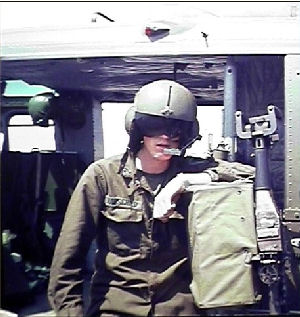
My tour started in 1972, I was assigned to the Royal Coachmen, 62nd assault helicopter company. In January of 1973 myself, Lt. Dixon, Lt. Steimle, WO1 King, and SP5 Daugherty were transferred from the 62nd to the Four Party Joint Military Commission, Region II, North I corps.
Image courtesy of Don Hauschild
|
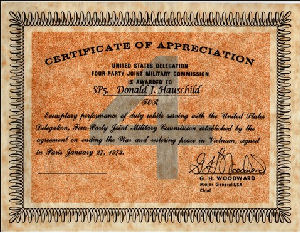
FPJMC certificate
Image courtesy of Don Hauschild
|

FPJMC Plaque
Image courtesy of Don Hauschild
|

This note was given to me by the NVA officer, in the Asha valley. We were the first Americans in there for some time. The place was ringed with radar controlled AA. The note is inviting us, the crew, to a hut for a little refreshment. We stayed with the bird.
Image courtesy of Don Hauschild
|
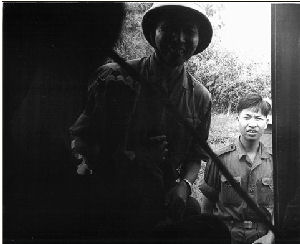
A US Army agency photo of the NVA officer who gave me the note and invitation. He also gave me some cigarettes.
Image courtesy of Don Hauschild
|

Yes these are the NVA cigarettes he gave me.
Image courtesy of Don Hauschild
|
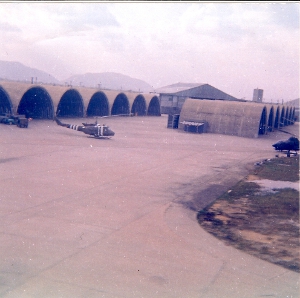
During Feb and March 1973 specially painted Hueys (some from F/4, with all weapons removed) were used by the Joint Military Commission to ferry US and South and North Vietnamese around the country to various functions. At least one F/4 pilot (WO Broadnax) was wounded during this period. This picture was taken at DaNang late March 1973.
Image courtesy of Wayne Moose
|
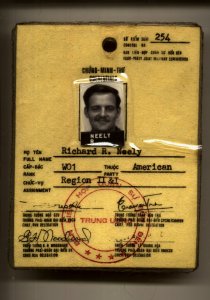
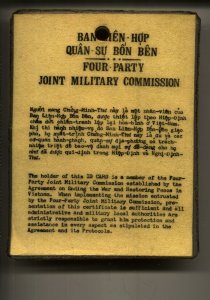
An ID Card for the members of the Four Party Joint Military Commission.
Image and information courtesy of Rich Neely, Four Party Joint Military Commission, Da Nang
Four Party Joint Military Commission. It was set up by the Cease Fire Agreement to arrange the transfer of POWs in South Vietnam. The principal members were senior officers from the South Vietnamese Military, Viet Cong, North Vietnamese Military, and US Military. As far as I know, no US POWs were released in any of these exchanges. Aircraft, crews, maintenance personnel, and administrative personnel were pulled from different units to support the mission. Our job was to transport these officers to different sites to arrange the transfers. Everyone was issued the yellow ID Card I sent you and all our aircraft had 3 broad orange bands painted on the fuselage. Some South Vietnamese CH-47s were used for transport of POWs. They were marked the same as our aircraft. Another group formed at the same time was the ICCS. Their mission was to support the international observers (Polish, Indonesians, Canadians, and one other I don't recall) called for in the Cease Fire Agreement. Their aircraft were marked with broad yellow stripes and the letters ICCS in black on a white background. We went into some areas where I never would have gone before. Too many people running around with AK-47s. When we landed, they were posted around the LZ watching us and we were unarmed except for personal weapons (pistols). At least one ICCS aircraft took fire (no damage) from an LZ we went into at a later date. This all made for some tense times. Didn't know if we were going to take fire on any given mission. We wore standard rank and branch insignia and 1st Aviation brigade shoulder patches, but nothing special for the FPJMC. My total hours flown in the two months with them (28 Jan 73 to 28 Mar 73) 68 hours.
|
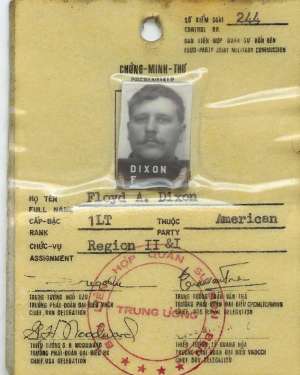
FPJMC I.D. card issued to Floyd
Image and information courtesy of Floyd Dixon (Buzz Dixon, "Buzzard")
Flying in support of the Four Party Joint Military Commision provided for some interesting if not
unusual missions. Basically we provided taxi service for the four parties
involved after the Peace Treaty was signed. This included flying out to
bad-guy country (unarmed except for side arms) to pick up the
representatives from the VC delegation. It was a little unnerving at first
because you always wondered about the 10% who didn't get the word not to
shoot at us. We would land at a clearing in the middle of nowhere and after
having lunch with the VC (yep, boiled rice and fish), would load them up and
head back to DaNang.
When the NVA arrived in DaNang, we flew a hush-hush (well, as hush-hush as
you can be in a Huey) mission in the middle of the night (started at
~1:00am) to transport them from the airfield to their compound in DaNang.
They arrived via USAF transports at night and would walk directly to our
aircraft to be transported across town to their compound. This mission
lasted several hours even using several aircraft. I believe the night
mission was mainly to avoid trouble with locals that werent too happy about
the visitors.
As I learned on later missions to sattelite compounds, there were quite a
few people that did not like the presence of some of the people we had
onboard. On more than one occasion, we landed at a compound that would have
protesters nearby. Fortunately, most missions went off without incident.
As far as the color of the paint scheme of the aircraft, ours were painted
with 4 orange stripes on the main fuselage and 4 on the tail boom (one
stripe for each party involved). Initially, we painted them with white
stripes. This did not go over well because some parties thought white
represented "surrender". As a result, we immediately had to repaint all
aircraft with orange stripes.
A downside to flying with the FPJMC was hours and hours of boredom. We
only flew 2-3 times a week, the rest of the time was hurry up and wait. Lots
of cards and darts. At one time I did have our orange armband with the number "4" but can't find it."
|
All images remain the personal property of this site and the contributor of the photo. You
may download them for your personal use but they may not be published or used
on any other site without written permission from the webmaster and the contributor.
|







